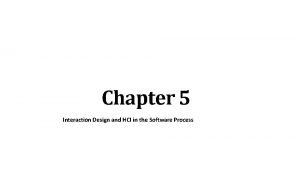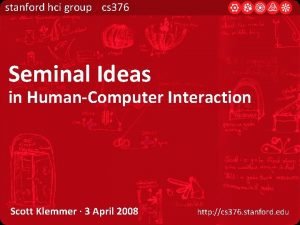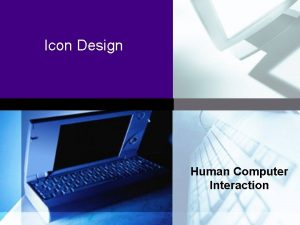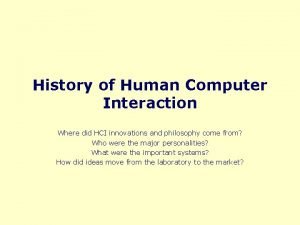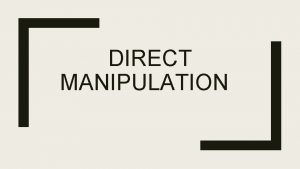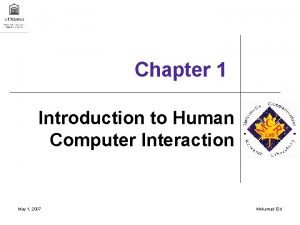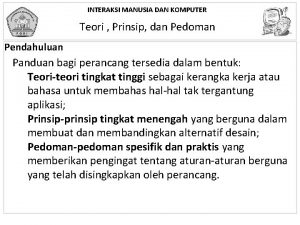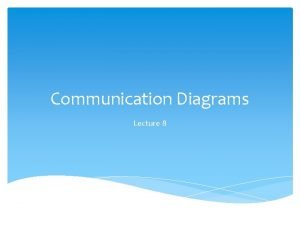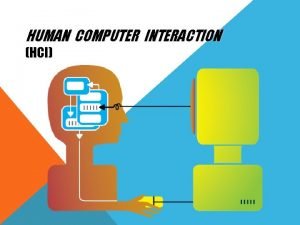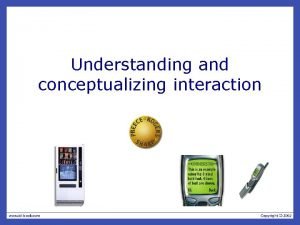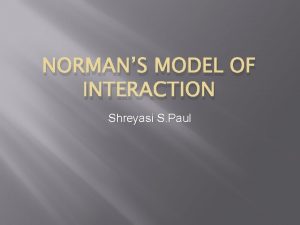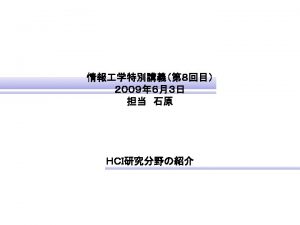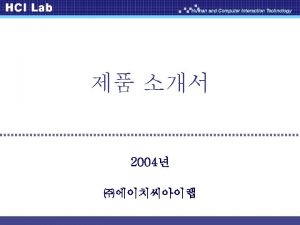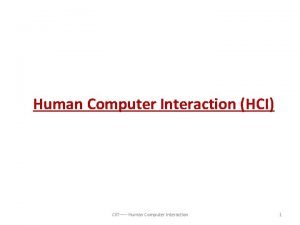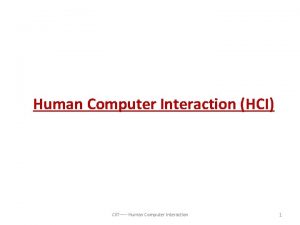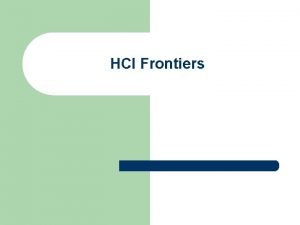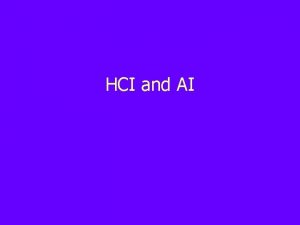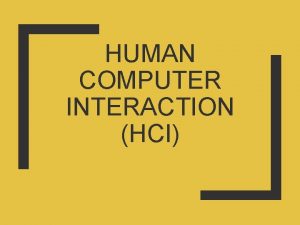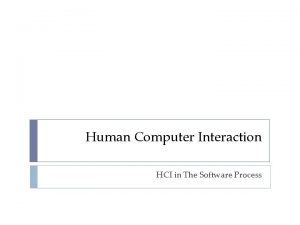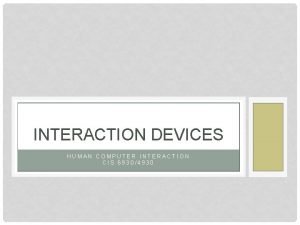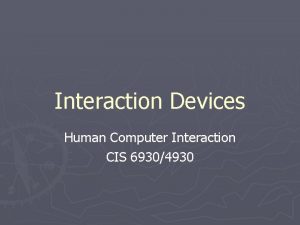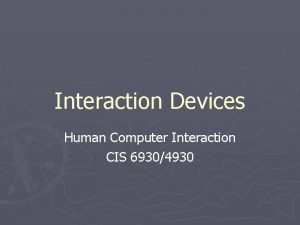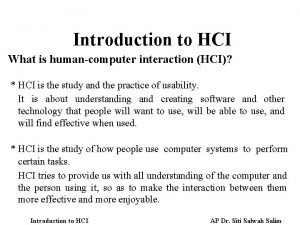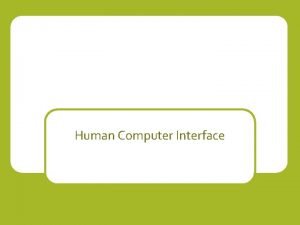Human Computer Interaction Lecture 14 HCI in Software


















- Slides: 18

Human Computer Interaction Lecture 14 HCI in Software Process

HCI in the software process • Software engineering and the design process for interactive systems • Usability engineering • Iterative design and prototyping • Design rationale

The Software Lifecycle • Software engineering is the discipline for understanding the software design process, or life cycle • Designing for usability occurs at all stages of the life cycle, not as a single isolated activity

The Waterfall Model Requirements specification Architectural design Detailed design Coding and unit testing Integration and testing Operation and maintenance

Activities in the Life Cycle Requirements specification designer and customer try capture what the system is expected to provide can be expressed in natural language or more precise languages, such as a task analysis would provide. Architectural design high-level description of how the system will provide the services required factor system into major components of the system and how they are interrelated needs to satisfy both functional and non-functional requirements. Detailed design refinement of architectural components and interrelations to identify modules to be implemented separately the refinement is governed by the non-functional requirements.

Verification and Validation Real-world requirements and constraints The formality gap Verification designing the product right Validation designing the right product The formality gap validation will always rely to some extent on subjective means of proof

The life cycle for interactive Systems cannot assume a linear sequence of activities as in the waterfall model Requirements specification Architectural design Detailed design Coding and unit testing lots of feedback! Integration and testing Operation and maintenance

Usability Engineering The ultimate test of usability based on measurement of user experience Usability engineering demands that specific usability measures be made explicit as requirements Usability specification – – usability attribute/principle measuring concept measuring method now level/ worst case/ planned level/ best case Problems – usability specification requires level of detail that may not be possible early in design satisfying a usability specification

ISO Usability Standard 9241 Adopts traditional usability categories: • Effectiveness – can you achieve what you want to? • Efficiency – can you do it without wasting effort? • Satisfaction – do you enjoy the process?

some metrics from ISO 9241 Usability objective Effectiveness measures Suitability Percentage of for the task goals achieved Appropriate for Number of power trained users features used Learnability Percentage of functions learned Error tolerance Percentage of errors corrected successfully Efficiency measures Satisfaction measures Time to Rating scale complete a task for satisfaction Relative efficiency Rating scale for compared with satisfaction with an expert user power features Time to learn Rating scale for criterion ease of learning Time spent on Rating scale for correcting errors error handling

Iterative Design and Prototyping • Iterative design overcomes inherent problems of incomplete requirements • Prototypes – simulate or animate some features of intended system – different types of prototypes • throw-away • incremental • Evolutionary • Management issues – – time planning non-functional features contracts

Techniques for prototyping Storyboards need not be computer-based can be animated Limited functionality simulations some part of system functionality provided by designers tools like Hyper. Card are common for these Wizard of Oz technique

Design Rationale Design rationale is information that explains why a computer system is the way it is. Benefits of design rationale – – – communication throughout life cycle reuse of design knowledge across products enforces design discipline presents arguments for design trade-offs organizes potentially large design space capturing contextual information

Design Rationale (cont’d) Types of DR: • Process-oriented – preserves order of reflection and decision-making • Structure-oriented – emphasizes post hoc structuring of considered design alternatives

Issue-based information system (IBIS) • basis for much of design rationale research • process-oriented • main elements: Issues – hierarchical structure with one ‘root’ issue Positions – potential resolutions of an issue Arguments – modify the relationship between positions and issues • g. IBIS is a graphical version

Structure of g. IBIS Position supports Argument responds to Issue responds to Position specializes objects to generalizes Sub-issue questions Sub-issue Argument

Design space analysis • Structure-oriented • QOC – hierarchical structure: Questions (and sub-questions) – represent major issues of a design Options – provide alternative solutions to the question Criteria – the means to assess the options in order to make a choice

The QOC notation Option Question … Criterion Consequent Question …
 Interaction design and hci in the software process
Interaction design and hci in the software process Stanford hci group
Stanford hci group Icon based logo
Icon based logo Graphical display in hci
Graphical display in hci What are input-output channels in hci
What are input-output channels in hci Hci douglas
Hci douglas What is direct manipulation in hci
What is direct manipulation in hci Hci chapter 1
Hci chapter 1 Pola pikir desainer imk dibawah ini adalah
Pola pikir desainer imk dibawah ini adalah Prinsip imk
Prinsip imk Interaction design syllabus
Interaction design syllabus Pengertian interaction
Pengertian interaction Alan dix hci
Alan dix hci Communication diagrams
Communication diagrams Ergonomics in human computer interaction
Ergonomics in human computer interaction Definition of human computer interaction
Definition of human computer interaction Hci interaction styles
Hci interaction styles Norman's interaction model
Norman's interaction model Modelling rich interaction
Modelling rich interaction
